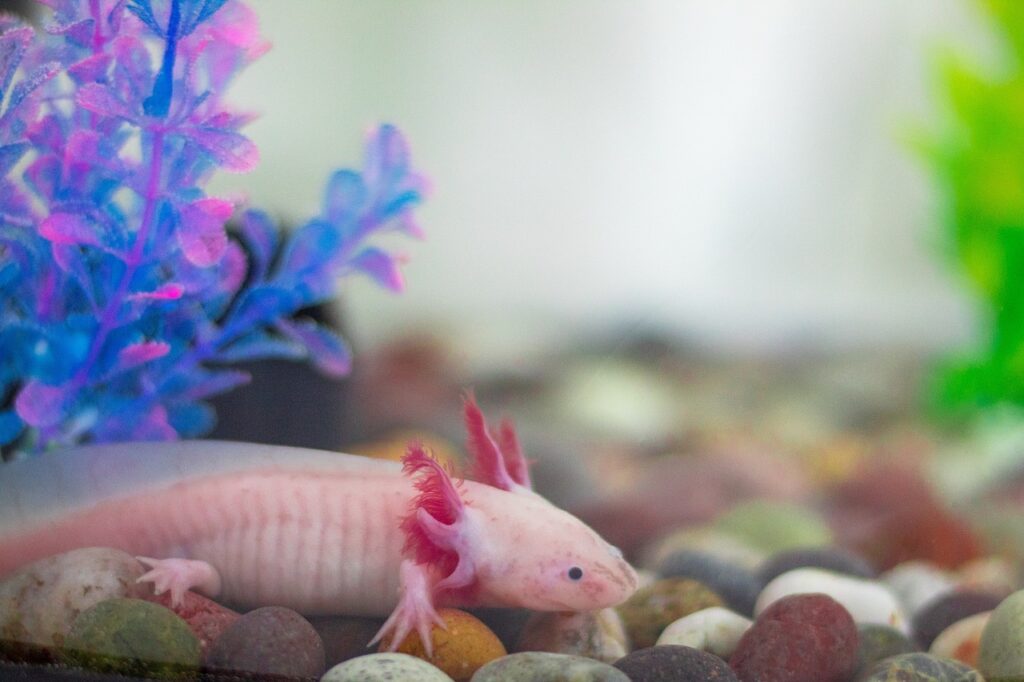Last Updated on April 21, 2024 by Amin Tawar
The axolotl, a fascinating amphibian native to Mexico, captivates hearts with its endearing smile and feathery gills. But beyond its adorable features lies a world of vibrant colors. Axolotls boast a remarkable range of pigmentations, each with a unique genetic story to tell. This comprehensive guide dives into the captivating world of axolotl colors, exploring the science behind their hues, the different morphs available, and how to care for these colorful creatures.
The Science of Axolotl Colors:
Axolotls owe their color variations to specialized cells called chromatophores. These tiny pigment factories within the skin come in three main types:
- Melanophores: Responsible for black, brown, and grey hues.
- Iridophores: Create iridescent and metallic shimmers through light reflection.
- Xanthophores: Produce yellow and orange pigments.
The distribution and interaction of these pigment cells determine the final color displayed by an axolotl. Additionally, genes dictate the production and distribution of these chromatophores, resulting in the various axolotl morphs we see today.
A Spectrum of Beauty: Exploring Axolotl Morphs
Selective breeding by hobbyists has led to the development of numerous axolotl morphs, each with distinct color patterns and combinations. Here’s a breakdown of some popular morphs:
| Morph Name | Description |
|---|---|
| Wild Type (Axolotl) | Brown or olive base with darker spots and a yellow or gold underbelly. This is the coloration most similar to axolotls found in the wild. |
| Leucistic Axolotl | Almost entirely white with black eyes. They lack melanophores but retain iridophores, resulting in a shimmering appearance. |
| Melanoid Axolotl | Dark pigmentation dominates, often appearing black or very dark grey with minimal lighter markings. |
| Axanthic Axolotl | Lacks both melanophores and xanthophores, resulting in a pale yellow or cream color with dark eyes. |
| Albino Axolotl | Completely white with pink eyes due to the absence of all pigment cells. |
| Piebald Axolotl | Large, irregular black patches contrasting with a lighter base color. |
| Harlequin Axolotl | Similar to Piebald but with smaller, more defined black markings. |
| Copper Axolotl | Metallic, coppery sheen over a light base color due to the abundance of iridophores. |
| Wild Type Axolotl with GFP | Genetically modified with a Green Fluorescent Protein (GFP) gene, making them glow green under UV light. |
Beyond the Basics: A Look at Lesser-Known Morphs
The world of axolotl morphs extends beyond the popular choices listed above. Here are some fascinating, less-common variations:
- Mosaic Axolotl: Patchwork of different colored areas with no clear dominant pattern.
- Chimera Axolotl: Two distinct color patterns on either side of the body, due to a developmental abnormality.
- Lucy Axolotl: Leucistic axolotl with yellow or orange markings, often on the head or gills.
- Dirty Leucistic Axolotl: Leucistic axolotl with some scattered dark speckles or patches.
A Guide to Caring for Colorful Axolotls
While axolotl colors are captivating, their health and well-being remain paramount. Here are some essential care tips to ensure your colorful companions thrive:
- Water Quality: Maintain clean, cool water (16-18°C or 60-64°F) with proper filtration and regular water changes.
- Diet: Axolotls are carnivores and require a diet of high-quality live food like earthworms, bloodworms, or brine shrimp.
- Tank Environment: Provide a spacious aquarium with hiding places, low-light conditions, and a sandy substrate to prevent impaction.
- Tank Mates: Axolotls are solitary creatures and shouldn’t be housed with other fish or amphibians who may injure them or compete for food.
Frequently Asked Questions (FAQs):
- What is the rarest axolotl color?
There’s no definitive answer as new morphs can emerge through breeding. However, some morphs like the Lavender Axolotl or the Axanthic Axolotl with Lucy pattern are less common.
- Do axolotl colors change as they grow?
Yes, axolotl colors can change slightly as they mature. However, the overall morph will remain the same.
- Can I breed axolotls for specific colors?
Yes, with knowledge of axolotl genetics and responsible breeding practices, you can attempt to breed axolotls for specific colors. However, it’s important to prioritize their health over aesthetics. Here’s what to consider:
- Understanding Recessive and Dominant Genes: Some color traits are dominant (expressed even with one copy of the gene) while others are recessive (requiring two copies for expression). Understanding these inheritance patterns is crucial for targeted breeding.
- Finding Reputable Breeders: Look for experienced breeders who prioritize the well-being of their axolotls and practice ethical breeding methods.
- Avoiding Inbreeding: Breeding closely related axolotls increases the risk of health problems. Reputable breeders will maintain diverse gene pools to prevent this.
- Focus on Overall Health: Prioritize healthy specimens with good genetics over solely focusing on color. A vibrant axolotl is a healthy axolotl!
The Allure of Axolotls: Beyond the Rainbow
Axolotls hold a special place in the hearts of many, not just for their captivating colors, but also for their unique biology and fascinating regenerative abilities. They serve as valuable research subjects, aiding in scientific advancements in areas like tissue regeneration and limb development. Additionally, their popularity in the pet trade has increased awareness about amphibian conservation.
Conclusion: A Spectrum of Wonder
Axolotls, with their diverse color palette and remarkable biology, continue to inspire curiosity and wonder. By appreciating their unique characteristics and providing proper care, we can ensure these colorful creatures continue to thrive for generations to come. Remember, while axolotl colors are undeniably captivating, their health and well-being should always be the top priority. So, the next time you encounter an axolotl, take a moment to appreciate not just their vibrant hues, but also the fascinating creature beneath the surface.
Sources:
- Axolotl – Wikipedia: https://en.wikipedia.org/wiki/Axolotl
- Axolotl City – Genetics https://www.axolotl.org/genetics.htm
- Axolotl Care Guide – PetMD: https://www.youtube.com/watch?v=aLvOL1kPZ1w
- The Axolotl: An Amazing Animal with Regenerative Powers by National Geographic: https://ambystoma.uky.edu/education/19-fun-facts-cat/65-why-do-axolotls-retain-a-juvenile-appearance-throughout-life
- The Axolotl – The University of Kent https://www.research.uky.edu/news/axolotls-genetically-indistinguishable-other-salamanders
